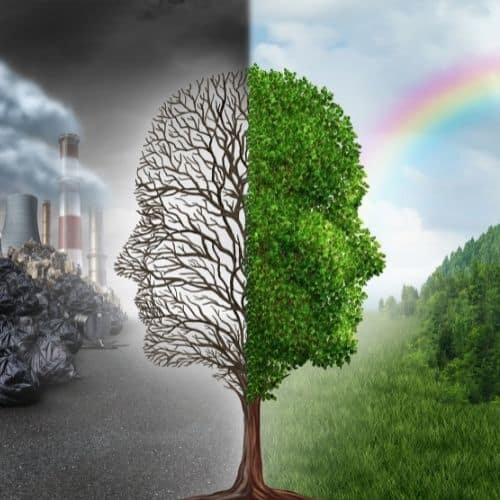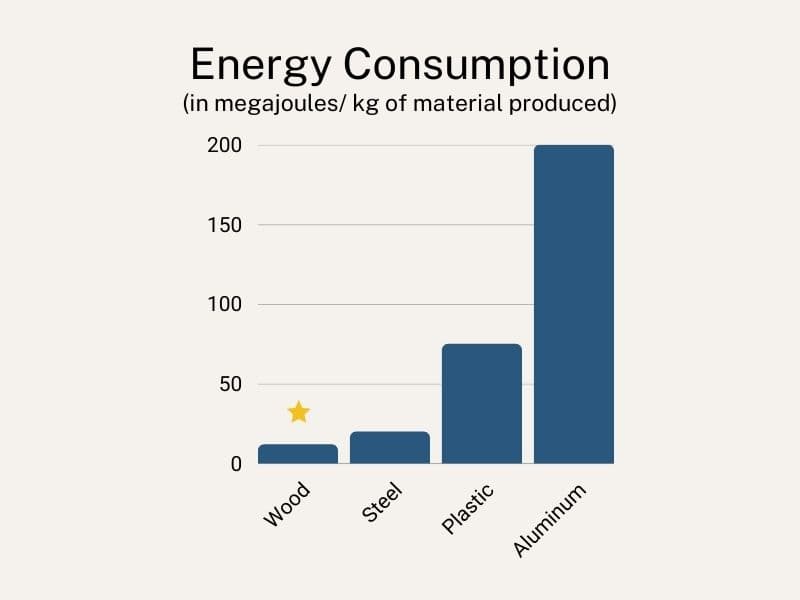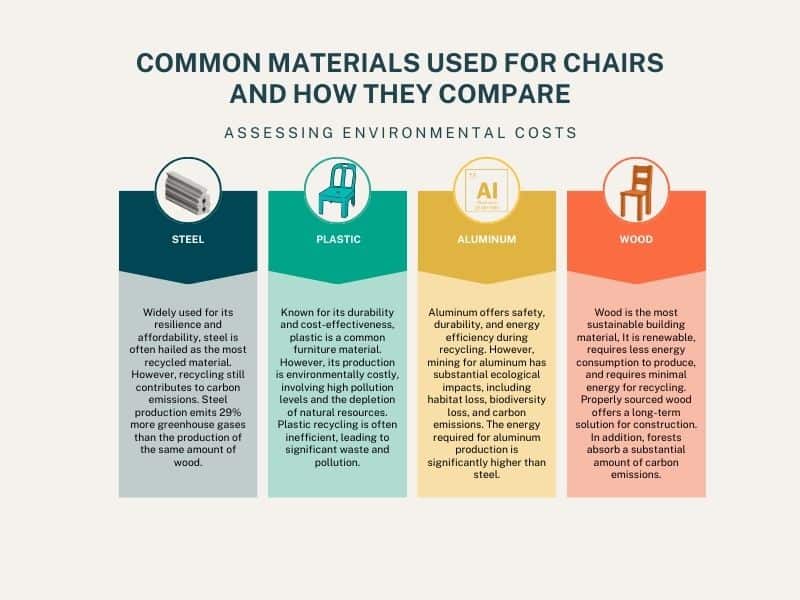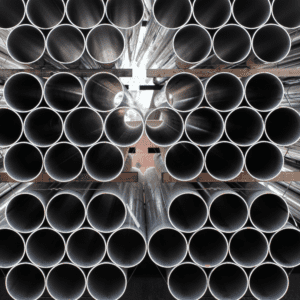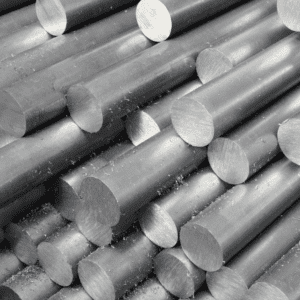What are the environmental effects of construction materials?
Historically, the responsibility of avoiding climate disasters has been placed on individuals, encouraging everyone to “do their part” by reducing, reusing, and recycling. That dynamic has been shifting. Over the past couple of years, there has been a dramatic push for businesses to dedicate resources to do their part in fighting climate change.
The concept of the “personal carbon footprint,” which places the responsibility of avoiding climate disaster on individuals, was a marketing campaign thought up and enacted by the BP oil company. Like a magician practicing sleight of hand, the idea of a personal carbon footprint was a case of misdirection.
We have spent many hours researching the environmental cost of different furniture materials, so you don’t have to. We hope this research helps you to create a more environmentally conscious business approach, both when it comes to construction material selections and when deciding what companies you want to do business with.
How Can Construction Material Selection Make a Difference?
This blog will outline the environmental impact of different construction materials used to manufacture furniture (and other products). Clear recommendations will be provided for the most sustainable and durable materials. This blog is intended for those who hope to minimize the environmental ramifications of the products they purchase.
Eustis Chair has manufactured luxury chairs for decades, with a focus on sustainability in both manufacturing and material selections. These core values have helped to keep Eustis Chair a growing, profitable business. Our customers appreciate the quality of our chairs in addition to the thoughtful design and sourcing of materials.
We believe companies should advocate for the needs of their customers, not just in the present but in the future as well. This is precisely why environmental efforts belong at the forefront of the minds of those who hope to secure long-term profits and keep customers coming back time and time again.
What happens to desks, chairs, and other furniture when no one wants them anymore?
Are they recycled? Can they be recycled? How does furniture manufacturing contribute to our global climate struggle?
Not all material and sourcing practices are created equal. There is often a correlation between cost and quality. Well-sourced and durable materials can come at a higher price point. It is important to understand what furniture materials best fit your needs.
Creating products from sustainable materials ensures that you will have reliable access to resources for the future. Choosing suitable (but unsustainable) materials could result in an inability to acquire such goods as they become scarce. This could cost you significant profits in the future.
In summary, thoughtful sourcing gives your business the ability to create a sustainable and customer-oriented long-term plan that will help ensure profits for decades.
Background
Recent studies show that the amount of CO2 in the air in the year 2020 was 417 parts per million. This much CO2 has not been present in the air on Earth since 4 million years ago (EPA). CO2 is the driving force of climate change and the cause of the increased precipitation, drought, and hurricanes we are currently witnessing. Collection, manufacturing, and disposal of raw materials are all ways that manufacturing processes can contribute to or work to eliminate climate change.
Climate scientists attribute much of the climate change issue to increased greenhouse gasses. Greenhouse gases, including CO2, methane, and nitrous oxide, are being produced at a rate natural greenhouse gas removers cannot mitigate. Greenhouse gas emissions have increased concerns about deforestation as, historically, forests are one of the primary ways the earth has to combat greenhouse gas emissions. What materials and manufacturing practices can help mitigate these disastrous impacts?
Steel
Steel is one of the most common building materials for both buildings and furniture items. It is often chosen for its resilience and low cost. Steel is cheaper than other building materials and has benefits like being lightweight, which means lower foundation costs. Presently, steel boasts that it’s the most recycled material of all the most common building materials.
What does it mean for something to be the “most recycled material?”
Though the general public understands recycling as one of the most beneficial ways to address climate change, it’s undergone significant criticism in recent years. Recycling, though better than materials ending up in the landfill, is inferior environmentally to reducing and reusing. Recycling still requires a manufacturing process, therefore, contributing to global carbon emissions in a way that could be avoided by reducing or reusing (BBC).
Additionally, the recycling industry struggles with a supply and demand mismatch. Much of the material put into recycling facilities end up being disposed of in landfills despite the best efforts of those recycling it. With their significant methane production, landfills ultimately contribute more to the problems of greenhouse gas emissions that are devastating our planet. A material getting “recycled” says very little about whether the material actually gets recycled or disposed of in an eco-friendly way.
Aside from recycling capabilities, the initial creation of steel versus wood is significantly greater. The graph on the next page (Exhibit A) details how steel production contributes to the number of greenhouse gases in our atmosphere compared to wood production. Steel production emits 29% more greenhouse gas than the production of the same amount of wood.
Plastic
Plastic is another material commonly used in the manufacturing of furniture. Plastic is applauded for being durable, inexpensive, and safe. It is so common, that it is present in a significant number of materials, often without buyers knowing it’s there (Green Building Solutions). Plastic can seem like the more financially conscious option for many reasons; it’s pest-repellent, weather-resistant, and inexpensive to replace. An additional benefit of plastic is that it is often used as a supplementary material to strengthen classic building materials like wood.
Why is plastic so bad for the environment?
The production of plastic is costly to the environment. Plastic made from crude oil produces astronomical levels of pollution during the production process and must be mined from the earth. Oil mining is responsible for the destruction of land, pollution of oceans, and significant air pollution.
Additionally, plastic is one of the most “recycled” materials. Plastic recycling is often neglected to protect the earth as it’s currently simply cheaper to make new plastic. The result is that much of the plastic in recycling bins gets redirected to landfills because of a lack of interest from buying groups. Since plastic is nearly indestructible, not recycling means that it is likely to stay on the planet for centuries. And we’re using it in massive, unsustainable quantities, producing around 359 tons a year (BBC). “According to the Global Footprint Network, before the pandemic, we were demanding 1.75 times the available resources of the planet.” (BBC).
Aluminum
Aluminum is a popular choice for indoor/ outdoor furniture for many reasons. It offers fire safety, durability, and thermal efficiency (Permalite).
Aluminum only requires 5% of the energy used to make the original product to construct the recycled version (Thesca). In fact, almost 75% of all the aluminum ever produced in the United States is still in circulation today.
Aluminum’s biggest issue is the arduous process that’s required to acquire it. Aluminum is found naturally under the earth’s surface and requires heavy machinery digging up acres of land to collect it. This sort of mining affects the plant and animal life of the region that is being mined. Because of how vast the land is that must be mined, the ecosystem surrounding these aluminum mines is affected for multiple generations. Habitat loss, biodiversity loss, carbon emissions, and erosion are all a product of mining aluminum (Thesca).
While the aluminum industry has created plans to restore and regrow the natural habitats once the mining is complete, it cannot mitigate the effects of the carbon emissions required to use the heavy machines. Once collected, it needs to be refined, which requires significant amounts of compounds like silica and iron oxides. The amount of energy needed to make aluminum is “211 GJ per ton, compared with 22.7 GJ per ton for steel” (Greenspec). So while recycling aluminum may only take 5% of the original energy costs, 5% may still be a considerable amount in terms of environmental damage (Greenspec).
While aluminum has many benefits in recycling, continuing to mine aluminum is not a sustainable choice. Aluminum can be recycled indefinitely, which means that this material doesn’t have to completely disappear from the landscape of material choices. Still, we must dramatically reduce its use because of the amount we currently have available.

Wood
Wood is the most sustainable building material. Sourcing sustainably manufactured wood and using it whenever possible in building projects is the only way it will be possible for construction to continue at the current production scale for the foreseeable future.
Wood is an entirely natural material. One of the many benefits of being a natural material is that wood can be regrown and reproduced after it’s harvested. Trees can be sustainably and repetitively grown through sustainable agricultural tree farming.
Tree farming can be 100% sustainable. In fact, with properly sourced water and thoughtful practices, tree farming can be sustainable in the long term. Not only is wood sustainable to grow new, but it can also be recycled for a fraction of the energy expenditure of other materials, such as steel.
Forests are one of our best resources to address the climate crisis. Large forests and the soil beneath them absorb about a quarter of all carbon emissions globally, making them a huge asset in addressing the damage we have already done to the climate in terms of emissions. Forests also help to minimize the effects of air pollution, which is produced in many other manufacturing processes.
Supporting sustainable wood production is one of the most important tools in addressing climate change and minimizing the effects of the problems we are already facing, all while keeping production levels at their current rate.
Case Study: Wood Promotes Health
Recent studies looked at the effect of building materials on an individual’s health. They found a correlation between wood buildings and the emotional state of individuals. Wood structures help individuals feel closer to nature. This triggers a physiological reaction of calm, decreasing stress levels in workplaces and classrooms that utilize wood.
Conclusion
In summary, wood is the most viable material for long-term sustainability. The other materials analyzed in this paper (plastic, steel, and aluminum) are not sustainable in the long term. When deciding which products to purchase, you should examine the source of your materials and consider the manufacturer’s sustainability goals and everyday actions.
References
“Aluminium Production & Environmental Impact.” Greenspec. Web. 21 Aug. 2021.
“Basic Information about Landfill Gas.” EPA. Environmental Protection Agency. Web. 21 Aug. 2021.“Benefits of Steel.” Pacific Northwest Steel Fabricators Association. Web. 21 Aug. 2021.
Cestari, Sibele. “Why Plastic Waste Is an Ideal Building Material.” BBC Future. BBC, 19 Aug. 2020. Web. 21 Aug. 2021.
Fairs, Marcus. “How Can We Reduce the Construction Industry’s Carbon Footprint?” World Economic Forum. 12 July 2021. Web. 21 Aug. 2021.
Fleider, Patty. “Plastic Building Materials: A Real Solution for Today’s Building Market.” Green Building Solutions. 08 Jan. 2017. Web. 21 Aug. 2021.
Gerretsen, Isabelle. “The State of the Climate in 2021.” BBC Future. BBC, 10 Jan. 2021. Web. 21 Aug. 2021.
“Plastic Building Materials: Common Types, Sources, Applications & Benefits.” Tangent. 30 May 2021. Web. 21 Aug. 2021.
Permalite. “Benefits of Aluminium.” Permalite. Web. 21 Aug. 2021.
Ross, Evan. “What Building Material (wood, Steel, Concrete) Has the Smallest Overall Environment Impact?” Debating Science. 21 Apr. 2016. Web. 21 Aug. 2021.
Sanders, Nicholas J. “U.S. Air Quality Is Getting Worse. Here Are the Costs.” PBS. Public Broadcasting Service, 23 Oct. 2019. Web. 21 Aug. 2021.
“What Are Greenhouse Gases?” David Suzuki Foundation. 12 Jan. 2021. Web. 21 Aug. 2021.
Wallenius, Marjut, et al. “Marjut WALLENIUS: PhD, Docent (Psychology): Tampere University, Tampere: UTA: School of Social Sciences and Humanities.” ResearchGate, 8 Feb. 2018, www.researchgate.net/profile/Marjut-Wallenius
To download this white paper, please click here for the .pdf version.
































